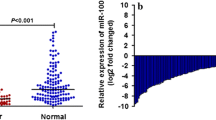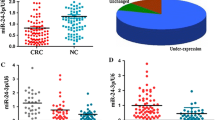Abstract
The purpose of the study was to investigate microRNA-223 (miR-223) expression in colorectal cancer (CRC) and its relationship with tumorigenesis and disease prognosis. Quantitative real-time PCR was used to measure levels of miR-223 in tumor samples and adjacent non-cancerous tissues from 62 patients undergoing radical resection for the treatment of CRC. The associations between miR-223 expression and patient age, sex, as well as clinicopathologic parameters, such as tumor size, differentiation, location, invasion depth, metastasis, tumor-node-metastasis (TNM) stage, and overall patient survival, were analyzed by Mann–Whitney U and Kruskal–Wallis tests. Kaplan–Meier method and Cox proportional hazards regression analyses were performed to estimate the prognostic factors for patient survival prediction. The expression of miR-223 was significantly upregulated in CRC tissues compared with adjacent non-cancerous tissues (P < 0.05). This overexpression was associated with TNM stage and lymph node and distant metastases, (P < 0.05). Moreover, Kaplan–Meier analysis demonstrated that patients with high miR-223 expression had a poorer overall survival (OS) than those with low miR-223 expression (P = 0.002). Univariate analysis revealed a statistically significant correlation between OS and miR-223 level, histology grade, metastasis and TNM stage (P < 0.001). Furthermore, miR-223 levels and histology grade were independently associated with OS (HR 0.204, 95 % CI 0.101–0.415, P < 0.05 and HR 2.252, 95 % CI 1.429–3.546, P < 0.05, respectively). The overexpression of miR-223 may play an important role in the progression of CRC and can be used as an independent factor to determine CRC prognosis.


Similar content being viewed by others
References
Jemal A, Bray F, Center MM, Ferlay J, Ward E, Forman D. Global cancer statistics. CA Cancer J Clin. 2011;61:69–90.
Li XM, Wang AM, Zhang J, Yi H. Down-regulation of miR-126 expression in colorectal cancer and its clinical significance. Med Oncol. 2011;28:1054–7.
Sun L, Hu H, Peng L et al. P-cadherin promotes liver metastasis and is associated with poor prognosis in colon cancer. Am J Pathol. 2011;179:380–90.
Lau NC, Lim LP, Weinstein EG, Bartel DP. An abundant class of tiny RNAs with probable regulatory roles in Caenorhabditis elegans. Science. 2001;294:858–62.
Ambros V. The functions of animal microRNAs. Nature. 2004;431:350–5.
Esquela-Kerscher A, Slack FJ. Oncomirs—microRNAs with a role in cancer. Nature Rev. 2006;6:259–69.
He L, Thomson JM, Hemann MT et al. A microRNA polycistron as a potential human oncogene. Nature. 2005;435:828–33.
Voorhoeve PM, le Sage C, Schrier M et al. A genetic screen implicates miRNA-372 and miRNA-373 as oncogenes in testicular germ cell tumors. Cell. 2006;124:1169–81.
Johnson SM, Grosshans H, Shingara J, et al. RAS is regulated by the let-7 microRNA family. Cell. 2005;120:635–47.
Mattie MD, Benz CC, Bowers J et al. Optimized high-throughput microRNA expression profiling provides novel biomarker assessment of clinical prostate and breast cancer biopsies. Mol Cancer. 2006;5:24.
Yanaihara N, Caplen N, Bowman E et al. Unique microRNA molecular profiles in lung cancer diagnosis and prognosis. Cancer Cell. 2006;9:189–98.
Gottardo F, Liu CG, Ferracin M, et al. Micro-RNA profiling in kidney and bladder cancers. Urol Oncol. 2007;25:387–92.
Streppel MM, Pai S, Campbell NR et al. MicroRNA 223 is upregulated in the multistep progression of Barrett’s esophagus and modulates sensitivity to chemotherapy by targeting PARP1. Clin Cancer Res. 2013;19:4067–78.
Li J, Guo Y, Liang X et al. MicroRNA-223 functions as an oncogene in human gastric cancer by targeting FBXW7/hCdc4. J Cancer Res Clin Oncol. 138:763–74.
Yao Y, Suo AL, Li ZF et al. MicroRNA profiling of human gastric cancer. Mol Med Rep. 2009;2:963–70.
Li X, Zhang Y, Zhang H et al. miRNA-223 promotes gastric cancer invasion and metastasis by targeting tumor suppressor EPB41L3. Mol Cancer Res. 2011;9:824–33.
Dong YW, Wang R, Cai QQ et al. Sulfatide epigenetically regulates miR-223 and promotes the migration of human hepatocellular carcinoma cells. J Hepatol. 2014;60:792–801.
Zhou K, Yi S, Yu Z et al. MicroRNA-223 expression is uniformly down-regulated in B cell lympho proliferative disorders and is associated with poor survival in patients with chronic lymphocytic leukemia. Leuk Lymphoma. 2012;53:1155–61.
Nian W, Ao X, Wu Y et al. miR-223 functions as a potent tumor suppressor of the Lewis lung carcinoma cell line by targeting insulin-like growth factor-1 receptor and cyclin-dependent kinase 2. Oncol Lett. 2013;6:359–66.
Acknowledgments
Our work was supported by National Key Clinical Medical Specialties Foundation and National Natural Science Foundation of China (81271916, 81301506).
Conflict of interest
The authors have no conflict of interest to declare.
Author information
Authors and Affiliations
Corresponding author
Rights and permissions
About this article
Cite this article
Li, Zw., Yang, Ym., Du, Lt. et al. Overexpression of miR-223 correlates with tumor metastasis and poor prognosis in patients with colorectal cancer. Med Oncol 31, 256 (2014). https://doi.org/10.1007/s12032-014-0256-5
Received:
Accepted:
Published:
DOI: https://doi.org/10.1007/s12032-014-0256-5




